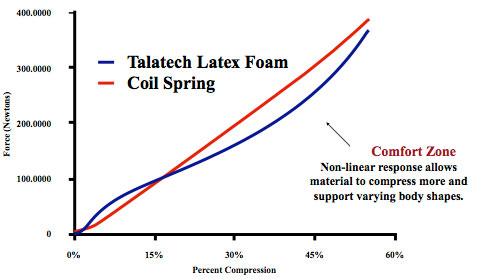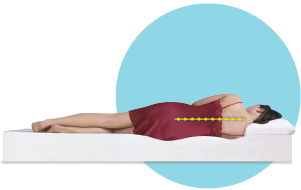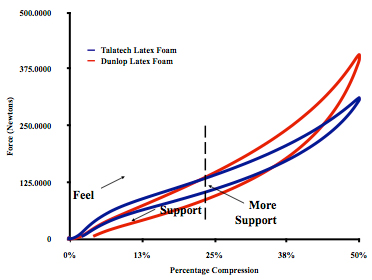TECHNICAL BLOG
KTT Enterprises works in close partnership with Talalay Global, located in Shelton CT, just a few miles away from our factory.
While KTT manufactures solid latex foam, our Talalay pincore material is supplied solely from Talalay Global.
The following content is authorized and provided by Talalay Global.
TalaWiki / TalaBlog / TalaTalk / Talalay Down the Truth / TalaTruth
FROM THE DESK OF DR. JOHN LEAN, PH.D., CHEMIST
Sometimes we find that we just have to go to the doctor and get some straightforward information about the facts and science behind latex.
BLOCK LATEX RUBBER BASICS
Block latex foam rubber is the general term used to describe latex foam rubber produced with a large enough cross section to be used for mattresses, pillows, and cushions. Block latex foam rubber is produced by two different processes: the Talalay Process and the Standard (Dunlop) Process. Both processes use the same basic ingredients: natural rubber latex (NR), polystyrene-‐butadiene rubber latex (SBR), soap, reinforcing filler, sulfur, and vulcanization agents.
Natural Rubber Latex – Naturally occurring polyisoprene polymer produced by rubber trees and extruded in the sap. The rubber tree sap is collected, concentrated, and preserved with ammonia before being sold.
Polystyrene-butadiene Rubber Latex – Polymer produced from styrene and butadiene designed to mimic and improve upon natural rubber. The polymer is produced in water on both batch and continuous production lines. After polymerization, the latex is stripped of residual reactants and concentrated before being sold.
Soap – Natural soaps are used to stabilize the various components in the mixture.
Reinforcing Filler – Hard materials are added to the mixture to increase firmness.
Reinforcing fillers are of two general types; mineral or plastic. Mineral fillers are generally aluminosilicates such as Feldspar or calcium carbonate (talc). The most commonly used plastic filler is polystyrene resin. Mineral fillers incorporate well into the rubber matrix and tend to be well dispersed. Plastic fillers are typically introduced as a latex and tend to form clusters in the rubber matrix. The plastic clusters are prone to breaking apart under use leading to softening.
Sulfur – Elemental sulfur forms crosslinks between polymer chains when heated giving the latex rubber foam strength and structure.
Vulcanization Agents – Agents used to increase the crosslinking rate and effectiveness of sulfur. The agents are typically consumed in the process. The above components are mixed together in a water based system to form what is termed compound for both processes.
THE TALALAY PROCESS
- Latex compound is injected with air and frothed to form foam.
- The foam is poured into an aluminum mold. The mold is only partially filled with foam.
- The mold is closed. The pressure inside the mold is reduced to create a pressure differential between the cavity of the mold and the air in the foam bubbles. Since the air in the foam bubbles is at atmospheric pressure and the mold pressure is lower than atmospheric, the air inside the bubbles expands causing the bubbles to increase in size expanding the foam. The foam expands and fills the mold. At the same time the foam redistributes itself evenly in the mold since the pressure inside the bubbles is driven to equalize over the entire block. Equalization of pressure in all the bubbles leads to a very uniform density throughout the foam block.
- The water in the foam is then frozen.
- After freezing, carbon dioxide is injected. The carbon dioxide reduces the pH of the foam and reduces the effectiveness of the soap at stabilizing the rubber in the latex. The rubber particles coalescence forming a continuous, open cell, solid block of foam rubber.
- The foam is heated to vulcanize the rubber.
- The foam is cooled and demolded.
- The foam block is washed and dried.
VIDEO - TALALAY LATEX FOAM PROCESS
STANDARD (DUNLOP) PROCESS
- Latex compound is injected with air, a gelling agent, and frothed to form foam. The gelling agent reduces the pH of the foam and reduces the effectiveness of the soap at stabilizing the rubber in the latex.
- The foam is poured into a mold until it completely fills the mold making it critical that the foaming process in well controlled to achieve an even density throughout the block.
- The mold is closed. The mold is allowed to rest until the gelling agent has enough time to destabilize the rubber in the latex. The rubber particles coalescence forming a continuous, open cell, solid block of foam rubber.
- The foam is heated to vulcanize the rubber.
- The foam is cooled and demolded.
- The foam block is washed and dried.
Advantages of the Talalay Process: the resulting feel, the uniformity, and the ability to reach low densities of the foam block as a result of the expansion of the foam to fill the mold under reduced pressure (rather than the complete filling of the mold as in the Standard (Dunlop) Process).Advantages of the Dunlop Process: shorter production times and ease of manufacture.
Talalay Comfort Zone
By: John Lean, Ph.D.
Director of Research and Development
Talalay Global - Shelton, Connecticut
Talalay Latex Rubber rubber has superior feel and comfort in bedding materials because of its unique compression profile. Compression is how a material responds to a weight or load being placed on it. A material will resist the load and push back in proportion to the load and the material’s ability to carry the load. The manner in which a material responds to a load defines how the material feels to the touch and how it supports the load. Below is a graph showing the amount of force needed to compress a piece of latex Rubber rubber and a coil spring a percentage of the original height.

As shown in the above graph, a coil spring has avery linear response to the appliedload. The linear response of a spring is an inherent property. Talalay Latex Rubber on the other hand responds to the applied load in a non-linear fashion. Initially Talalay Latex Rubber increases in firmness in response to the load, but as the load increases Talalay Latex Rubber compresses to a greater extent. Talalay Latex Rubber will support just as much weight at the coil spring, but it has more give keeping the material from having the feeling of bottoming out.

The increased compressibility of Talalay Latex Rubber is what allows the material to shape itself and comform to the human body. The human body’s profile is not flat and its weight distribution is not even. A coil spring is only able to respond to a body’s weight and not its shape. Talalay Latex Rubber with its non-linear compression curve can respond to a body’s weight and shape. A person may have similar weight distribution between the shoulders and hips, but the body parts have very different shapes.
Talalay Latex Rubber has the ability to allow for more compression without a proportional increase in weight to conform to various body shapes and weights.
Also contributing to Talalay Latex Rubber’s unique feel and support is the material’s resiliency. Resiliency is the amount of energy returned by a material after compression. Resiliency in a Rubber material is important for support. Below is a graph of showing the compression and decompression of Talalay Latex Rubber and a Dunlop latex Rubber. The arrows indicate compression and decompression.
Dunlop latex Rubber behaves more like a coil spring on compression with a fairly linearincrease in compression with load until the material cannot be compressed much more. Talalay Latex Rubber once again has an initial increase in firmness followed by increased compressibility under load. Upon decompression, Talalay Latex Rubber is much more resilient than Dunlop latex Rubber providing more support to thebody. Talalay Latex Rubber is able to compress more at a given load while at the same time return more energy and provide increased support.

The unique, non-linear compression profile of Talalay Latex Rubber is the result of the material’s large, open cell structure. Every cell of Talalay Latex Rubber behaves as a micro-spring.
The initial increase in firmness upon compression is the result of the latex Rubber cells resisting the compression until the cells buckle. Cell buckling results in the non-linear response of Talalay Latex Rubber to compression. Talalay Latex Rubber has a more non- linear response than Dunlop latex Rubber because of its larger cell size.
Buckling latex Rubber cells are nothing to worry about since there are hundreds of other cells backing them up. Talalay Latex Rubber cells are also made of one of the most durable materials around, rubber, so they bounce back into shape. The millions of Talalay Latex Rubber cells work together to provide just the right amount of support and comfort.

